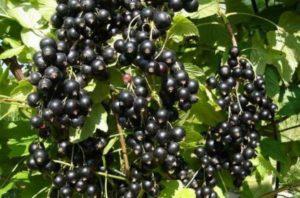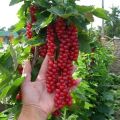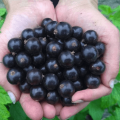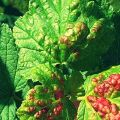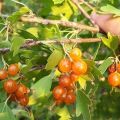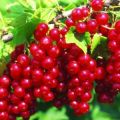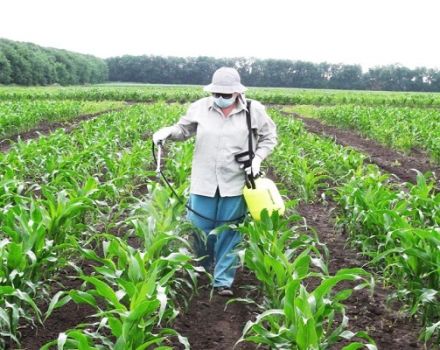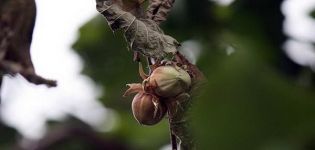Description and characteristics of the Pygmy currant variety, planting and care
The black currant of the Pygmy variety is called one of the most successful achievements of the domestic breeding of the kofnets of the last century. Possessing many advantages, it is in great demand, both by summer residents and owners of personal plots, and by small farmers, agricultural organizations.
Selection of currant pygmy
The variety was created in the South Ural Research Institute of Horticulture and Potato Growing (YUNIISK). The "parents" of Pygmy are such varieties as Karelskaya (Bredthorpe is the Finnish name) and Dove Seedling. The creator of the variety - Ilyin V.S. Included in the State Register and approved for use in 1999.
Main advantages and disadvantages
The advantages of this variety are:
- large-fruited;
- dense, crack-resistant skin;
- dessert (sweet) taste of ripe berries;
- frost resistance;
- drought resistance;
- high resistance to such dangerous and harmful fungal diseases as anthracnose and powdery mildew.
The only drawback of the variety is the average resistance to kidney mites, white leaf spot (septoria blight).
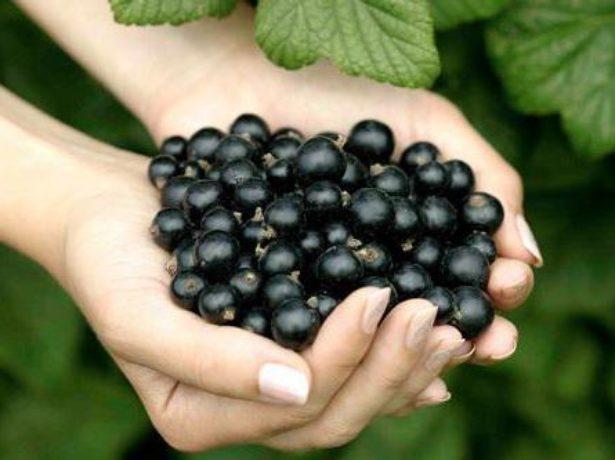
Variety characteristics
The characteristics of this variety include a description of its appearance, yield indicators, resistance to low temperatures, droughts, terms of picking berries, their transportability and storage.
External descriptions of culture
An adult and fruiting plant of the Pygmy variety is a compact shrub 1.5-2 meters tall, consisting of erect, pale pink shoots. The leaves of this variety are large, rich green. The front part of the leaf blades is shiny, strongly corrugated, the back is smooth, matte.
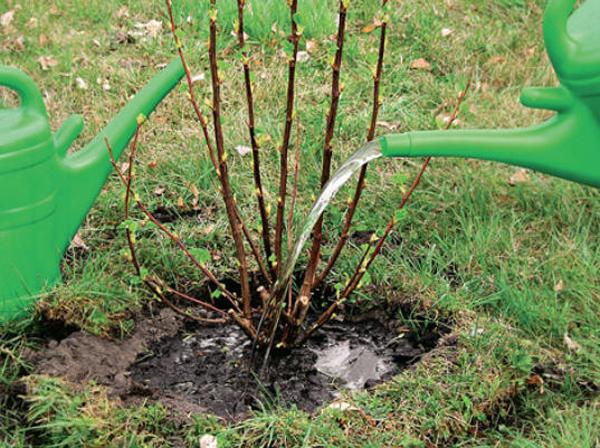
Flowering and yield
The main characteristics of the variety include a description of the timing and duration of flowering, ripening, harvesting ripe berries, crop yield, transportability and storage of the harvested crop.
Flowers and pollination
The flowers of this variety are voluminous, having a pale green color, collected in large clusters of 5-10 pieces each. Pygmy is a self-fertile variety that does not require pollinating insects.However, the proximity to such varieties as Yadrenaya, Bagheera, Lucia allows, with additional cross-pollination, to increase the yield of the Pygmy plantation by 10-15%.
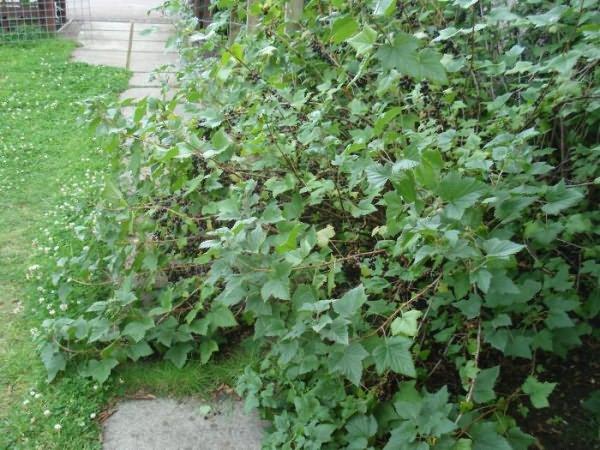
Ripening terms
Amicable ripening of this variety is observed in late June and early July. This process is delayed with coolness at the beginning of summer, prolonged rains, strong hurricane winds, prolonged drought.
How and when to pick berries
Harvesting is carried out in dry and warm weather, in the early morning (after dew) or in the evening. It is not recommended to pick berries at the peak of the daytime heat, after heavy rainfall. When ripe, the berries are harvested not one by one, but with whole brushes. In case of uneven ripening, a large number of small and green berries in clusters, they are cut off one by one.
In order for the berries not to be injured by their own weight, wide and shallow plastic containers are used for their collection and transportation.
Transportability and storage of fruits
Ripe Pygmy berries are resistant to cracking. Due to this advantage, the varieties of berries, when properly harvested, can withstand transportation well over long distances. They are also well stored: fresh, in the refrigerator, their shelf life, on average, is 3-4 weeks, in frozen - up to 2 years.
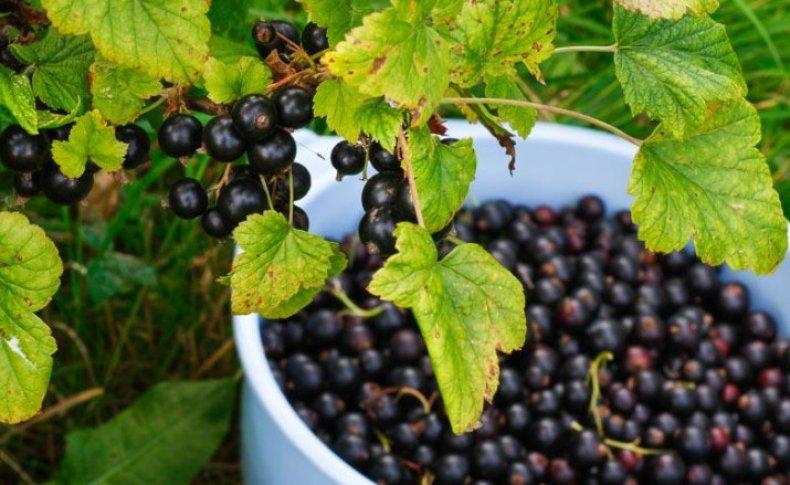
Frost and drought resistance
According to these two characteristics, the black currant of the Pygmy variety has very good indicators:
- healthy and adult bushes of this variety are able to withstand both spring frosts up to -5-7 and severe winter frosts down to -35 ;
- the variety is resistant to prolonged droughts in the spring-autumn period. This phenomenon has the most detrimental effect on the yield of the variety in the phases of flowering and berry setting.
Thanks to these features, this variety can be cultivated both in the Middle lane and in the more severe climate of Siberia.
Susceptibility to disease and insects
The variety is highly resistant to powdery mildew, septoria blight, double leaves. Pygmy is relatively resistant to damage by diseases such as septoria. Among pests, this variety is relatively resistant to currant kidney mites, aphids, moths, moths.
Planting currant bushes on the site
When growing currant bushes of the Pygmy variety, it is very important to choose the right seedlings, choose the most suitable places for the plantation, dig the planting hole, and directly carry out the planting process itself.
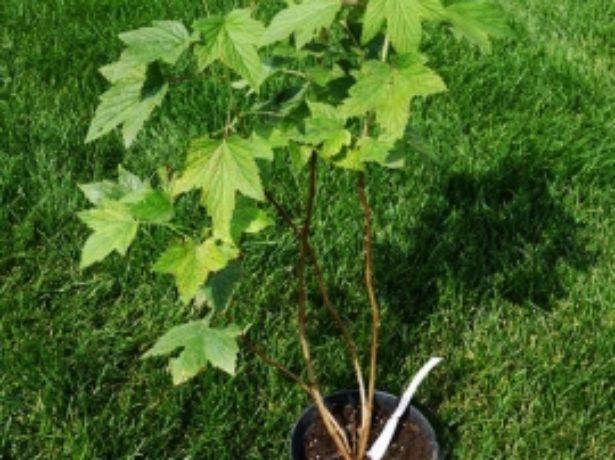
How to choose the right seedlings for planting
When choosing a seedling, it is necessary to be guided by the following requirements for the state of its aboveground and underground parts:
- age - well-formed two-year-old seedlings with 2-3 healthy shoots, without foliage, with healthy, not swollen buds are used for planting;
- the height and condition of the aboveground part are the most viable, and seedlings with an aboveground part 40-60 centimeters high and a shoot thickness of at least 8 millimeters at the base take root best;
- length and condition of the root system - in order to provide the aboveground part with the necessary nutrients, the root system of the seedling should consist of 4-5 roots, with a minimum length of 20 centimeters;
- the condition of the bark of the shoots - the bark on the shoots must be healthy, not mechanically damaged.
Also, a sticker indicating the nursery and reproduction must be attached to the seedling. All requirements for blackcurrant seedlings are regulated by such a document as GOST R 53135-2008.
Drop off location
For this variety of black currant, they choose well-lit areas located on hills with the following characteristics:
- the type of soil in terms of its mechanical composition is cohesive sandy loam or well-drained light loam;
- the level of fertility is high, characterized by a humus content of more than 2%, available forms of phosphorus and exchangeable potassium - at least 180 milligrams per kilogram of soil;
- the level of soil (ground) waters is not closer than 1 meter from the surface;
- acidity (pH) - 5.5-6.0.
All soil indicators of the selected area can be found out with a paid analysis of a soil sample at a local agrochemical laboratory.
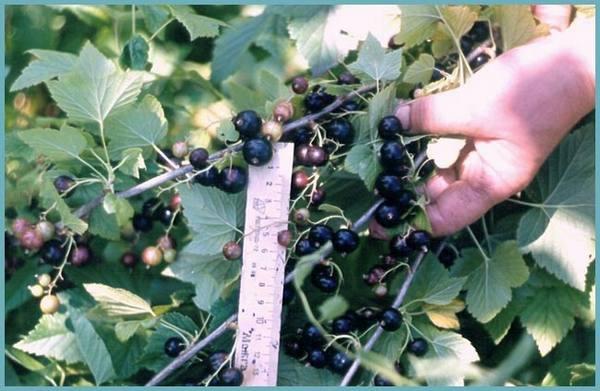
Landing time and technology
Saplings of Pygmy litter are planted either in early spring or in late autumn. At the same time, the autumn period is more preferable, since the established and overwintered seedling in early spring will already start growing, and with normal care it will hurt less, and will begin to bear fruit faster.
Landing technology consists of the following stages:
- Pre-planting soil preparation - the site is treated with a general orientation of glyphosate-containing herbicides (Rainbow, Hurricane), dug up or plowed to the depth of the fertile layer.
- Digging of landing holes - holes with a diameter of 50 centimeters and a depth of 40 centimeters are made in the selected area.
- Preparation of a mixture of organic and mineral fertilizers - for filling the hole, in addition to fertile soil, use a mixture consisting of 2 buckets of compost, 170 grams of simple superphosphate, 75 grams of potassium sulfate, 300 grams of wood ash.
- Moistening the bottom of the hole - 10-12 liters of water are poured onto the bottom of the hole, lightly sprinkled with fertile soil.
- Placing a seedling in a hole - a seedling in a planting hole is placed strictly vertically or at an angle of 45 ... The root collar of the seedling should be 6-8 centimeters below soil level.
- Backfilling the hole - by placing the seedling in the center of the hole, it is first covered with a mixture of compost and mineral fertilizers, and then with fertile soil.
- Watering - after the hole is filled, an annular groove is made around the seedling, into which 8-10 liters of water are poured.
- Mulching - after the moisture has been absorbed, the soil around the seedling is covered with a layer of mulch (peat, sawdust, humus) 5-7 centimeters thick.
The scheme for planting black currants using this technology (distance between plants × row spacing) is 1.5 × 2.5 meters.
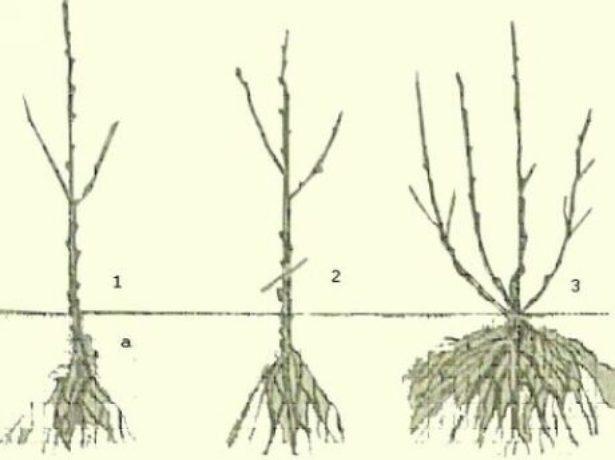
How to properly care for a shrub?
Seedling care consists of watering, fertilizing, soil cultivation, pruning, protection from pests and diseases, and shelter for the winter.
Irrigation and feeding
The most demanding currant bushes for watering in the following growth phases:
- flowering - the formation of ovaries;
- ripening of berries.
During these periods, the bushes are watered 2-3 times during the week. Also, abundant watering is carried out with a moisture deficit, warming the bushes before winter (water charging watering). The irrigation rate in any of these periods should ensure soil moisture under the bushes to a depth of 40-45 centimeters. On average, on sandy loam and loamy soils, it is 25-30 liters of water per 1 adult bush.

During the first 2 years, young currants are fed only in early spring, before bud break. 65 grams of ammonium nitrate or 45-50 grams of urea is added to this top dressing under each bush in dry form. Urea must be closed up by loosening.
Fruiting bushes over the age of 3 years are fed with nitrogen fertilizers 2-3 times per season:
- In the spring (before bud break) - at this time, fertilizing is carried out on wet soil, with ammonium nitrate at a dose of 65-70 grams of ammonium nitrate per 1 bush.
- In the phase of green ovaries, currant bushes are fed during this phase with a solution of urea (50 grams of fertilizer per 10 liters of water) or dry ammonium nitrate at a dose of 70 grams per 1 bush.
Phosphorus and potassium are applied every year, under the autumn digging or loosening of the soil, in the form of 210 grams of simple superphosphate and 70 grams of potassium sulfate per 1 bush.
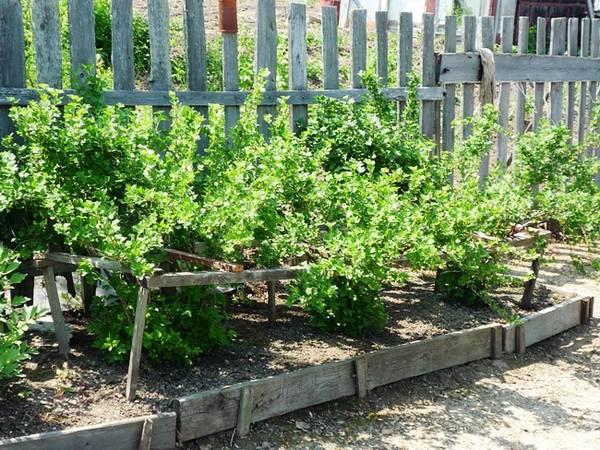
Soil care
Caring for the soil on a currant plantation of this variety consists of the following operations:
- early spring loosening to a depth of 10-12 centimeters;
- summer loosening and weeding near bushes to a depth of 5-10 centimeters;
- autumn digging of row spacings and loosening the soil near the bushes to a depth of no more than 10 centimeters.
When using mulch, summer loosening is not performed.
Trimming and shaping
In the first 3 years, to give the bush the required shape, height and productivity, formative pruning is performed:
- 1 year - the aerial part is shortened at a height of 20 centimeters (cut at the level of 3 kidneys);
- 2 years - lateral branches of the 2nd order are shortened at the level of 4-5 buds;
- 3 years - thin out the root shoots, removing the shoots that thicken the bush.
In subsequent years, the bush is cut 3 times:
- In the spring, all shoots and side branches damaged by frost, rodents and wind are cut off.
- In summer, when aphid foci, viral diseases are detected, the affected shoots are removed at ground level, after which they are immediately burned.
- In the fall, all unripe annuals, broken, creeping and growing old shoots inside the bush are removed from the bush.
A properly cut and formed bush should consist of 15-20 shoots 2-3 years old.
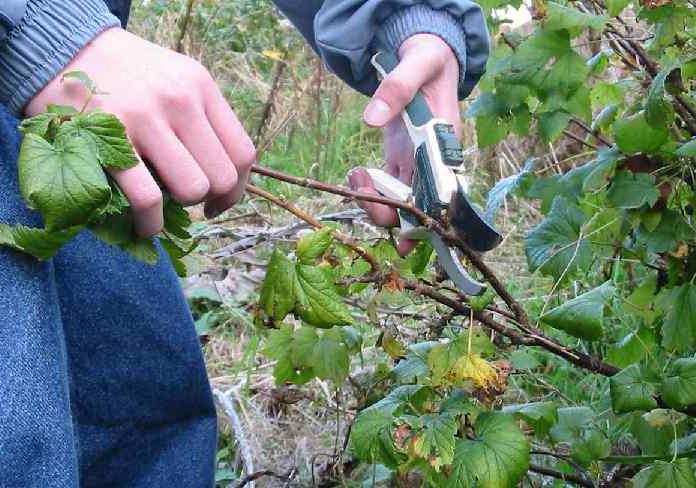
Preventive treatment against pests and diseases
The following insecticides are used to control pests (kidney mites, aphids, moth and moth):
- Kinmix;
- Prophylactin;
- Fitoverm;
- Tanrek from aphids.
Against fungal infections, the bushes are treated with fungicides such as:
- Bordeaux liquid;
- Topaz;
- Bayleton;
- Tiovit Jet.
Against pests, currants are treated in early spring and during the period of mass appearance of pests. Fungicidal treatments are carried out when more than 5% of the leaf surface is damaged by pathogens.
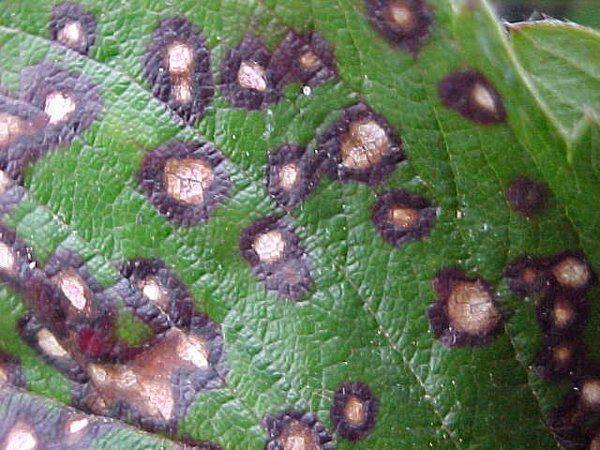
Protection from winter cold
To protect against frost, after the foliage has fallen, the bushes in late autumn are carefully prepared for the upcoming cold weather as follows:
- Pruning is carried out by removing old, broken, unripe shoots.
- They introduce mineral fertilizers, dig up the aisles, loosen the soil near the bushes.
- Watering the bushes.
- Healthy stems are collected in bunches of 3-4 pieces, wrapped with agrofibre and, bending to the ground, pressed down with bricks.
- The shoots insulated in this way are additionally sprinkled with a layer of earth 4-5 centimeters thick.
Currant bushes prepared and insulated in this way can withstand frosts down to -40 .
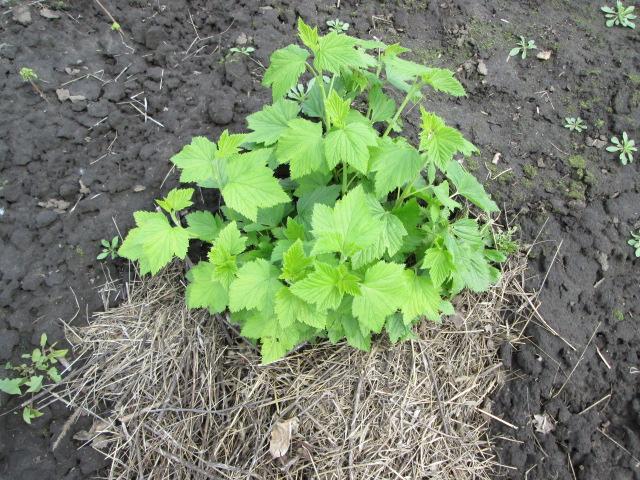
Reviews of the variety Pygmy
Testimonials of summer residents and owners of personal plots testify to the popularity and numerous advantages of this variety.
Oleg:
“A very good variety. For 7 years now I have been growing it at my summer cottage, and I do not regret the labor spent on it. I collect large and sweet berries up to 5 kilograms from one bush. I not only freeze the harvest and use it for various homemade preparations, but also sell it. There is no end to buyers. "
Anastasia Pavlovna:
“Of all the varieties of black currants that grow in my dacha, Pygmy is the most productive and unpretentious. His berry is very tasty and large. In addition to jams and preserves, my fastidious city grandchildren eagerly eat it fresh. In general, I recommend this variety to all fellow gardeners and gardeners. "
Stanislav:
Pygmy is my favorite blackcurrant variety. Its beautiful bushes reaching 2 meters give a harvest of sweet and very large berries, which are well suited both for various preservation and for fresh consumption. I recommend it to all those who are tired of looking for a universal variety for summer residents. "

